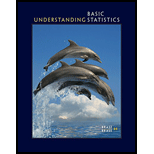
Concept explainers
z Scores: Fawns Fawns between 1 and 5 months old in Mesa Verde National Park have a body weight that is approximately
Convert each of the following z intervals to x intervals.
(g) Interpretation If a fawn weighs 14 kilograms, would you say it is an unusually small animal? Explain using z values and Figure 7-12.
(h) Interpretation If a fawn is unusually large, would you say that the z value for the weight of the fawn will be close to
(a)
The z intervals from x interval
Answer to Problem 10P
Solution: The z intervals from x interval is
Explanation of Solution
We use the formula for normal distribution:
(b)
The z intervals from x interval
Answer to Problem 10P
Solution: The z intervals from x interval is
Explanation of Solution
We use the formula for normal distribution:
(c)
The z intervals from x interval
Answer to Problem 10P
Solution: The z intervals from x interval is
Explanation of Solution
We use the formula for normal distribution:
(d)
The x intervals from z interval
Answer to Problem 10P
Solution: The x intervals from z interval is
Explanation of Solution
We use the formula for normal distribution:
(e)
The x intervals from z interval
Answer to Problem 10P
Solution: The x intervals from z interval is
Explanation of Solution
We use the formula for normal distribution:
(f)
The x intervals from z interval
Answer to Problem 10P
Solution: The x intervals from z interval is
Explanation of Solution
We use the formula for normal distribution:
(g)
Whether a fawn weighing 14 kilograms would be unusually small animal.
Answer to Problem 10P
Solution: Yes, we can say that it is an unusually small animal.
Explanation of Solution
We use the formula for normal distribution:
According to Figure 7-12, 99.7% of the data values lie within 3 standard deviation of the means. Since the obtained z-value is -3.07 is below three standard deviation of mean, hence we can say that fawn weighing 14 kilograms would be unusually small animal.
(h)
The z value for a fawn to be unusually large.
Answer to Problem 10P
Solution: The z value for a fawn to be unusually large is 3.
Explanation of Solution
Want to see more full solutions like this?
Chapter 7 Solutions
Understanding Basic Statistics
- A company found that the daily sales revenue of its flagship product follows a normal distribution with a mean of $4500 and a standard deviation of $450. The company defines a "high-sales day" that is, any day with sales exceeding $4800. please provide a step by step on how to get the answers in excel Q: What percentage of days can the company expect to have "high-sales days" or sales greater than $4800? Q: What is the sales revenue threshold for the bottom 10% of days? (please note that 10% refers to the probability/area under bell curve towards the lower tail of bell curve) Provide answers in the yellow cellsarrow_forwardFind the critical value for a left-tailed test using the F distribution with a 0.025, degrees of freedom in the numerator=12, and degrees of freedom in the denominator = 50. A portion of the table of critical values of the F-distribution is provided. Click the icon to view the partial table of critical values of the F-distribution. What is the critical value? (Round to two decimal places as needed.)arrow_forwardA retail store manager claims that the average daily sales of the store are $1,500. You aim to test whether the actual average daily sales differ significantly from this claimed value. You can provide your answer by inserting a text box and the answer must include: Null hypothesis, Alternative hypothesis, Show answer (output table/summary table), and Conclusion based on the P value. Showing the calculation is a must. If calculation is missing,so please provide a step by step on the answers Numerical answers in the yellow cellsarrow_forward
 Big Ideas Math A Bridge To Success Algebra 1: Stu...AlgebraISBN:9781680331141Author:HOUGHTON MIFFLIN HARCOURTPublisher:Houghton Mifflin Harcourt
Big Ideas Math A Bridge To Success Algebra 1: Stu...AlgebraISBN:9781680331141Author:HOUGHTON MIFFLIN HARCOURTPublisher:Houghton Mifflin Harcourt Glencoe Algebra 1, Student Edition, 9780079039897...AlgebraISBN:9780079039897Author:CarterPublisher:McGraw Hill
Glencoe Algebra 1, Student Edition, 9780079039897...AlgebraISBN:9780079039897Author:CarterPublisher:McGraw Hill Holt Mcdougal Larson Pre-algebra: Student Edition...AlgebraISBN:9780547587776Author:HOLT MCDOUGALPublisher:HOLT MCDOUGAL
Holt Mcdougal Larson Pre-algebra: Student Edition...AlgebraISBN:9780547587776Author:HOLT MCDOUGALPublisher:HOLT MCDOUGAL


